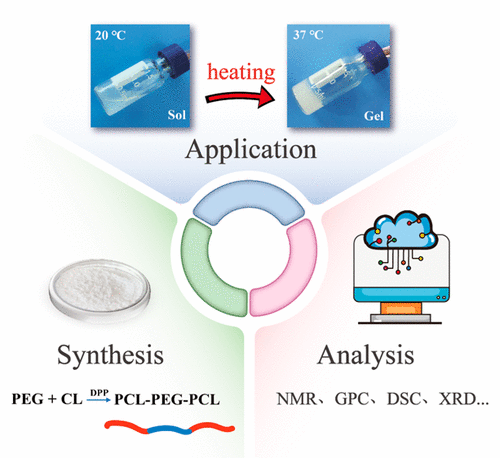当前位置:
X-MOL 学术
›
J. Chem. Educ.
›
论文详情
Our official English website, www.x-mol.net, welcomes your
feedback! (Note: you will need to create a separate account there.)
Synthesis of PCL–PEG–PCL Triblock Copolymer via Organocatalytic Ring-Opening Polymerization and Its Application as an Injectable Hydrogel—An Interdisciplinary Learning Trial
Journal of Chemical Education ( IF 2.5 ) Pub Date : 2020-10-20 , DOI: 10.1021/acs.jchemed.0c00325 Kaiting Wu 1 , Lin Yu 1 , Jiandong Ding 1
Journal of Chemical Education ( IF 2.5 ) Pub Date : 2020-10-20 , DOI: 10.1021/acs.jchemed.0c00325 Kaiting Wu 1 , Lin Yu 1 , Jiandong Ding 1
Affiliation

|
Biocompatible and biodegradable block copolymers composed of poly(ethylene glycol) (PEG) and aliphatic polyester are a class of promising biomaterials. Herein, a teaching experiment was designed to furnish undergraduates with a reliable method to synthesize an amphiphilic poly(ε-caprolactone)-PEG-poly(ε-caprolactone) (PCL–PEG–PCL) triblock copolymer via ring-opening polymerization of ε-caprolactone using PEG as the macroinitiator and diphenyl phosphate as the green organocatalyst; the concentrated solution of synthetic polymer in water was then demonstrated as an injectable thermogel with a sol–gel transition upon heating. Ten students serving as volunteers successfully synthesized PCL–PEG–PCL copolymer, and then analyzed their specimens using various techniques including proton-nuclear magnetic resonance spectroscopy, gel permeation chromatography, differential scanning calorimetry, and X-ray diffraction and learned the principles of instruments. Finally, students prepared an aqueous polymer solution, and observed its interesting spontaneous physical gelation upon heating via the tube-inverting approach and dynamic rheological analysis. The experimental features captured the students’ attention and made them more enthusiastic participants. This newly designed teaching experiment afforded senior undergraduates an excellent opportunity to consolidate basic concepts and principles in books with practical experimental sessions in the field of polymer chemistry, analytical chemistry, and materials science.
中文翻译:

有机催化开环聚合反应合成PCL–PEG–PCL三嵌段共聚物及其在可注射水凝胶中的应用-跨学科研究
由聚(乙二醇)(PEG)和脂肪族聚酯组成的生物相容性和可生物降解的嵌段共聚物是一类有前途的生物材料。在此,设计了一个教学实验,为大学生提供一种可靠的方法,以通过ε-的开环聚合反应来合成两亲性聚(ε-己内酯)-PEG-聚(ε-己内酯)(PCL-PEG-PCL)三嵌段共聚物使用PEG作为大分子引发剂和磷酸二苯酯作为绿色有机催化剂的己内酯; 然后证明了合成聚合物在水中的浓缩溶液是可注射的热凝胶,加热后会发生溶胶-凝胶转变。十名志愿服务的学生成功地合成了PCL–PEG–PCL共聚物,然后使用各种技术(包括质子核磁共振波谱法)分析了他们的标本,凝胶渗透色谱,差示扫描量热法和X射线衍射,并了解了仪器的原理。最后,学生们准备了一种聚合物水溶液,并通过试管倒置法和动态流变学分析观察到了有趣的自发物理胶凝现象。实验功能吸引了学生的注意力,并使他们变得更加热情。这项新设计的教学实验为高年级本科生提供了绝佳的机会,可以在高分子化学,分析化学和材料科学领域的实践实验课中巩固书籍中的基本概念和原理。并通过管反转法和动态流变分析观察到加热后其有趣的自发物理胶凝。实验功能吸引了学生的注意力,并使他们变得更加热情。这项新设计的教学实验为高年级本科生提供了绝佳的机会,可以在高分子化学,分析化学和材料科学领域的实践实验课中巩固书籍中的基本概念和原理。并通过管反转法和动态流变分析观察到加热后其有趣的自发物理胶凝。实验功能吸引了学生的注意力,并使他们变得更加热情。这项新设计的教学实验为高年级本科生提供了绝佳的机会,可以在高分子化学,分析化学和材料科学领域的实践实验课中巩固书籍中的基本概念和原理。
更新日期:2020-11-12
中文翻译:

有机催化开环聚合反应合成PCL–PEG–PCL三嵌段共聚物及其在可注射水凝胶中的应用-跨学科研究
由聚(乙二醇)(PEG)和脂肪族聚酯组成的生物相容性和可生物降解的嵌段共聚物是一类有前途的生物材料。在此,设计了一个教学实验,为大学生提供一种可靠的方法,以通过ε-的开环聚合反应来合成两亲性聚(ε-己内酯)-PEG-聚(ε-己内酯)(PCL-PEG-PCL)三嵌段共聚物使用PEG作为大分子引发剂和磷酸二苯酯作为绿色有机催化剂的己内酯; 然后证明了合成聚合物在水中的浓缩溶液是可注射的热凝胶,加热后会发生溶胶-凝胶转变。十名志愿服务的学生成功地合成了PCL–PEG–PCL共聚物,然后使用各种技术(包括质子核磁共振波谱法)分析了他们的标本,凝胶渗透色谱,差示扫描量热法和X射线衍射,并了解了仪器的原理。最后,学生们准备了一种聚合物水溶液,并通过试管倒置法和动态流变学分析观察到了有趣的自发物理胶凝现象。实验功能吸引了学生的注意力,并使他们变得更加热情。这项新设计的教学实验为高年级本科生提供了绝佳的机会,可以在高分子化学,分析化学和材料科学领域的实践实验课中巩固书籍中的基本概念和原理。并通过管反转法和动态流变分析观察到加热后其有趣的自发物理胶凝。实验功能吸引了学生的注意力,并使他们变得更加热情。这项新设计的教学实验为高年级本科生提供了绝佳的机会,可以在高分子化学,分析化学和材料科学领域的实践实验课中巩固书籍中的基本概念和原理。并通过管反转法和动态流变分析观察到加热后其有趣的自发物理胶凝。实验功能吸引了学生的注意力,并使他们变得更加热情。这项新设计的教学实验为高年级本科生提供了绝佳的机会,可以在高分子化学,分析化学和材料科学领域的实践实验课中巩固书籍中的基本概念和原理。































 京公网安备 11010802027423号
京公网安备 11010802027423号